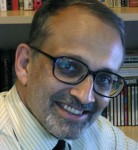Solid State Circuits Society
IEEE Santa Clara Valley Chapter
October 19, 2006
Our speaker was Dr. Asad A. Abidi (UCLA) and the topic of his presentation was ” Evolution of a CMOS Software-Defined Radio Receiver Front-End. “
Abstract
More than ever before, there is need today for a single receiver that is tunable over a wide range of bands, say from 800 MHz to 5.5 GHz, and which can receive channels from narrow bands typical of cellular voice channels (200 kHz) to wideband channels (20 MHz) typical of WLAN. This flexibility requires a wideband front-end, and pushing, as much as possible, the role of customized or application-specific analog circuits into the digital domain. It is soon realized that at least in mobile platforms, an A/D converter that can handle the wide bandwidth and dynamic range across many bands is the main hurdle. This paper will describe how a trail of research off the mainstream has led to a discrete-time analog signal processing scheme that solves the problems of anti-aliased sampling and minimum necessary variable gain in a highly programmable and compact form, while relegating as much as possible to the digital domain. The embedded A/D converters required here dissipate only tens of milliwatts.
Biography
Asad A. Abidi received the B.Sc.(Hon.) degree from Imperial College, London in 1976 and the M.S. and Ph.D. degrees in Electrical Engineering from the University of California, Berkeley in 1978 and 1981. He was at Bell Laboratories, Murray Hill, NJ from 1981 to 1984 as a Member of Technical Staff in the Advanced LSI Development Laboratory. Since 1985, he has been at the Electrical Engineering Department of the University of California, Los Angeles where he is Professor.
Asad Abidi has been involved in RF-CMOS research since the beginning. This has involved developing CMOS RF circuit building blocks and various receivers and transmitters either as replacements for solutions in other technologies, or new CMOS-specific concepts. Many of these are now part of standard industrial practice. In the past three years he and his group have focused on the development of a software-defined receiver and transmitter.
Welcome
Calendar
| M | T | W | T | F | S | S |
|---|---|---|---|---|---|---|
| 1 | 2 | 3 | 4 | 5 | ||
| 6 | 7 | 8 | 9 | 10 | 11 | 12 |
| 13 | 14 | 15 | 16 | 17 | 18 | 19 |
| 20 | 21 | 22 | 23 | 24 | 25 | 26 |
| 27 | 28 | 29 | 30 | 31 | ||
